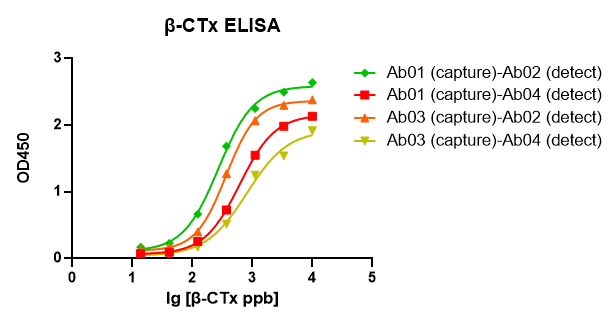Bone metabolism & osteoporosis Diagnostics
Diagnostic antibodies and antigens for Companion Animal disease testing
● Rabbit
Diagnostic antibodies and antigens for Swine disease testing
Diagnostic antibodies and antigens for Avian disease testing
Diagnostic antibodies and antigens for Multiple animal disease testing
Diagnostic antibodies and antigens for Ruminant disease testing
● Deer
Diagnostic antibodies and antigens for infectious and non-infectious Equine/Horse disease testing
SOCAIL MEDIA

Table of Contents
Case Study: GeneMedi's GMP-h-β-CTx-Ab pairs (Anti-human β-CTx mouse monoclonal antibody) are validated to detect the GMP-h-β-CTx-Ag01 (Recombinant human β-CTx Protein) in ELISA
Evidence has shown activated osteoclasts create resorption pits with low pH to dissolve the inorganic matrix and lysomal enzymes, such as TRAP and cathepsin K, effectively digest the exposed type-1 collagen releasing specific degradation products, such as the carboxyl-terminal cross-linked telopeptides of type I collagen (CTX-1). The biomarker β-CTx offers significant information on bone metabolism (bone remodeling) and is useful to predict fracture risk and to monitor the treatment efficacy. Recently, our R&D department demonstrated that our GMP-h-β-CTx-Ab pairs have a large linear range and good sensitivity against the GMP-h-β-CTx-Ag01. Below is the result of GeneMedi’s GMP-h-β-CTx-Ab01/02/03/04 (Anti-human β-CTx mouse monoclonal antibody) validation with GMP-h-β-CTx-Ag01 (Recombinant human β-CTx Protein) in ELISA. We highly recommend the Ab01-Ab02 pair and Ag to you.

GDU-products for Bone metabolism monitoring& osteoporosis Diagnostics
Novel biological markers have been developed, and studies suggest that they may be valuable research tools for investigating the mechanisms of bone metabolism and assessing the activity of osteocytes, and some of them may be of value for the management of patients with osteoporosis and other bone diseases. To better predict fracture risk and monitor the treatment efficacy of osteoporosis and other bone diseases, GDU offers diagnostic antibodies and antigens for the biomarkers, such as CTX-1, P1NP, N-MID OC, PTH and 25-OH-VD. These biomarkers can be used on the bone metabolism panel.
| Cat No. | Biomarker | Physiological process | Clinical value |
| GMP-h-β-CTx | β-isomerized C-terminal telopeptides (β-CTx), Beta-CrossLaps (beta-CTx) | Bone resorption | Evaluate bone resorption rate |
| GMP-h-PINP | procollagen type I N-terminal propeptide (PINP), amino-terminal propeptide of type 1 procollagen (P1NP) | Bone formation | Evaluate bone formation rate |
| GMP-h-N-MID-OC | N-terminal midfragment of Osteocalcin (N-MID OC) | Bone formation | Evaluate bone formation rate |
| GMP-h-PTH | parathyroid hormone (PTH) | Calcium cycle | Evaluate hypercalcemia/ hypocalcemia/ hyperparathyroidism |
| GMP-SMT-25-OH-VD3/2 | 25 hydroxyvitamin D (25-OH-(VD3+VD2)) | Calcium cycle | Evaluate vitamin D sufficiency |
| GMP-SMT-25-OH-VD-3 | 25-hydroxy (OH) Vitamin D3 (25-OH-VD-3) | Calcium cycle | Evaluate vitamin D sufficiency |
Introduction of Bone metabolism (bone remodeling), calcium cycle, and osteoporosis
Bones are not inert structures within the human body; they continue to change over the course of a lifespan. Bone metabolism is characterized by an intimate cooperation of bone cells including osteoblasts, osteoclasts, and osteocytes in order to maintain bone tissue quantity and the integrity of bone structure. This process of skeletal change is also known as bone remodeling, which both protects the structural integrity of the skeletal system and metabolically contributes to the body’s balance of calcium and phosphorus. Remodeling entails the resorption of old or damaged bone, followed by the deposition of new bone material. It is mainly regulated by osteoclastic bone destruction and osteoblastic bone formation. Besides, osteocytes also have a role in this process as well.
The bone remodelling cycle lasts 150–200 days and is primarily mediated by osteoblastic signals which promote the differentiation and maturation of osteoclast precursors. Activated osteoclasts create resorption pits with low pH to dissolve the inorganic matrix and lysomal enzymes, such as TRAP and cathepsin K, effectively digest the exposed type-1 collagen releasing specific degradation products,such as the carboxyl-terminal cross-linked telopeptides of type I collagen (CTX-1). Osteoblasts are attracted to this eroded surface and begin to form new osteoid. Type-1 collagen, abundant in osteoblasts, is secreted as a procollagen precursor molecule into the extracellular space where it is cleaved at the amino- and carboxy-terminals releasing pro-peptides into the blood. The procollagen type I N-terminal propeptide (P1NP) and osteocalcin (OC) are the the most sensitive markers of bone formation rate. Although labile, assay of intact osteocalcin (iOC) is established as the standard assay for evaluating osteoblastic function. Study examines the clinical usefulness of the newly developed immunoradiometric assay for osteocalcin (OC), which identifies the stable N-terminal midfragment of OC (N-MID OC assay). The findings suggest that N-MID OC immunoreactivity is much more stable than iOC immunoreactivity and that N-MID OC assay may be less susceptible to the OC fragments reported to accumulate in uremic serum. It may, therefore, prove more reliable than iOC assay for evaluating bone turnover, and thus for reflecting bone loss. Initially hydroxyapatite crystals are deposited in the osteoid then a slower mineralisation process continues over several months, followed by a period of quiescence. RANKL, an essential osteoclastogenic cytokine, is expressed on the surface of osteoblasts, it binds to its cellular receptor RANK on pre-osteoclasts and promotes their differentiation and activation. OPG a decoy receptor for RANKL, is secreted by osteoblasts and other stromal derived cells and reduces bone resorption by binding to RANK and preventing osteoclastic activity.

Calcium as a nutrient is most commonly associated with the formation and metabolism of bone. Bone tissue serves as a reservoir for and source of calcium for these critical metabolic needs through the process of bone remodeling. Calcium metabolism is regulated in large part by the parathyroid hormone (PTH)–vitamin D endocrine system, which is characterized by a series of homeostatic feedback loops. The rapid release of mineral from the bone is essential to maintain adequate levels of ionized calcium in serum. During vitamin D deficiency states, bone metabolism is significantly affected as a result of reduced active calcium absorption. This leads to increased PTH secretion as the calcium sensing receptor in the parathyroid gland senses changes in circulating ionic calcium. Increased PTH levels induce enzyme activity (1α-hydroxylase) in the kidney, which converts vitamin D to its active hormonal form, calcitriol. In turn, calcitriol stimulates enhanced calcium absorption from the gut. Not surprisingly, the interplay between the dynamics of calcium and vitamin D often complicates the interpretation of data relative to calcium requirements, deficiency states, and excess intake.

In metabolic bone diseases such as osteoporosis, bone metabolism is altered, leading to bone loss that is often accompanied by changes in the microarchitecture that result in bone fragility and ultimately fracture.
Osteoporosis Diagnostics and Therapy Monitoring: Bone remodeling markers and calcium cycle markers
Osteoporosis is a systemic skeletal disorder characterized by low bone mass, micro-architectural deterioration of bone tissue leading to bone fragility, and consequent increase in fracture risk. It is the most common reason for a broken bone among the elderly. Bones that commonly break include the vertebrae in the spine, the bones of the forearm, and the hip. Until a broken bone occurs there are typically no symptoms. Bones may weaken to such a degree that a break may occur with minor stress or spontaneously. After the broken bone heals, the person may have chronic pain and a decreased ability to carry out normal activities. Monitoring of patients treated for osteoporosis should include regular contact with a health care professional to ensure that: (1) medication is taken regularly and correctly, (2) calcium and vitamin D intake are sufficient, (3) the patient has no adverse effects or fear of adverse effects that must be addressed, and (4) there are no comorbidities or other medications that might alter the expected treatment effect.
The development of serum and urinary assays for biochemical markers, reflecting either enzymatic activities of osteoblasts and osteoclasts or breakdown products of bone tissue, has been very useful for investigating the complex pathways of bone metabolism and their alterations in bone diseases. The biomarkers, such as CTX-1, P1NP, N-MID OC, PTH and 25-OH-VD, offer significant information on bone metabolism (bone remodeling) and calcium cycle and are useful to predict fracture risk and to monitor the treatment efficacy.




